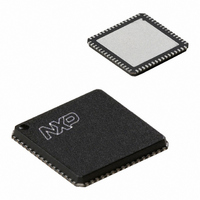LPC2138FHN64/01,55 NXP Semiconductors, LPC2138FHN64/01,55 Datasheet - Page 22

LPC2138FHN64/01,55
Manufacturer Part Number
LPC2138FHN64/01,55
Description
IC ARM7 MCU FLASH 512K 64-HVQFN
Manufacturer
NXP Semiconductors
Series
LPC2100r
Specifications of LPC2138FHN64/01,55
Program Memory Type
FLASH
Program Memory Size
512KB (512K x 8)
Package / Case
64-VQFN Exposed Pad, 64-HVQFN, 64-SQFN, 64-DHVQFN
Core Processor
ARM7
Core Size
16/32-Bit
Speed
60MHz
Connectivity
I²C, Microwire, SPI, SSI, SSP, UART/USART
Peripherals
Brown-out Detect/Reset, POR, PWM, WDT
Number Of I /o
47
Ram Size
32K x 8
Voltage - Supply (vcc/vdd)
3 V ~ 3.6 V
Data Converters
A/D 16x10b; D/A 1x10b
Oscillator Type
Internal
Operating Temperature
-40°C ~ 85°C
Processor Series
LPC21
Core
ARM7TDMI-S
Data Bus Width
16 bit, 32 bit
Data Ram Size
32 KB
Interface Type
I2C/SPI/SSP/UART
Maximum Clock Frequency
60 MHz
Number Of Programmable I/os
47
Number Of Timers
2
Operating Supply Voltage
3 V to 3.6 V
Maximum Operating Temperature
+ 85 C
Mounting Style
SMD/SMT
3rd Party Development Tools
MDK-ARM, RL-ARM, ULINK2, KSK-LPC2138, KSK-LPC2138-PL
Development Tools By Supplier
OM10045, OM10070, OM10089
Minimum Operating Temperature
- 40 C
On-chip Adc
2 (8-ch x 10-bit)
On-chip Dac
1-ch x 10-bit
Lead Free Status / RoHS Status
Lead free / RoHS Compliant
For Use With
568-4310 - EVAL BOARD LPC2158 W/LCD568-4298 - BOARD EVAL LPC213X KS213X568-4297 - BOARD EVAL LPC21XX MCB2100MCB2130UME - BOARD EVAL MCB2130 + ULINK-MEMCB2130U - BOARD EVAL MCB2130 + ULINK2MCB2130 - BOARD EVAL NXP LPC213X ARM FAM622-1005 - USB IN-CIRCUIT PROG ARM7 LPC2K568-2095 - BOARD EVAL FOR LPC213X ARM MCU
Eeprom Size
-
Lead Free Status / Rohs Status
Lead free / RoHS Compliant
Other names
568-4011
935281779557
LPC2138FHN64/01
935281779557
LPC2138FHN64/01
NXP Semiconductors
LPC2131_32_34_36_38
Product data sheet
6.18.1 Crystal oscillator
6.18.2 PLL
6.18.3 Reset and wake-up timer
6.18 System control
On-chip integrated oscillator operates with external crystal in range of 1 MHz to 30 MHz
and with external oscillator up to 50 MHz. The oscillator output frequency is called f
the ARM processor clock frequency is referred to as CCLK for purposes of rate equations,
etc. f
Section 6.18.2 “PLL”
The PLL accepts an input clock frequency in the range of 10 MHz to 25 MHz. The input
frequency is multiplied up into the range of 10 MHz to 60 MHz with a Current Controlled
Oscillator (CCO). The multiplier can be an integer value from 1 to 32 (in practice, the
multiplier value cannot be higher than 6 on this family of microcontrollers due to the upper
frequency limit of the CPU). The CCO operates in the range of 156 MHz to 320 MHz, so
there is an additional divider in the loop to keep the CCO within its frequency range while
the PLL is providing the desired output frequency. The output divider may be set to divide
by 2, 4, 8, or 16 to produce the output clock. Since the minimum output divider value is 2,
it is insured that the PLL output has a 50 % duty cycle. The PLL is turned off and
bypassed following a chip reset and may be enabled by software. The program must
configure and activate the PLL, wait for the PLL to Lock, then connect to the PLL as a
clock source. The PLL settling time is 100 μs.
Reset has two sources on the LPC2131/32/34/36/38: the RESET pin and watchdog reset.
The RESET pin is a Schmitt trigger input pin with an additional glitch filter. Assertion of
chip reset by any source starts the wake-up timer (see wake-up timer description below),
causing the internal chip reset to remain asserted until the external reset is de-asserted,
the oscillator is running, a fixed number of clocks have passed, and the on-chip flash
controller has completed its initialization.
When the internal reset is removed, the processor begins executing at address 0, which is
the reset vector. At that point, all of the processor and peripheral registers have been
initialized to predetermined values.
The wake-up timer ensures that the oscillator and other analog functions required for chip
operation are fully functional before the processor is allowed to execute instructions. This
is important at power on, all types of reset, and whenever any of the aforementioned
functions are turned off for any reason. Since the oscillator and other functions are turned
off during Power-down mode, any wake-up of the processor from Power-down mode
makes use of the wake-up timer.
•
•
•
Match register updates are synchronized with pulse outputs to prevent generation of
erroneous pulses. Software must ‘release’ new match values before they can become
effective.
May be used as a standard timer if the PWM mode is not enabled.
A 32-bit Timer/Counter with a programmable 32-bit Prescaler.
osc
and CCLK are the same value unless the PLL is running and connected. Refer to
All information provided in this document is subject to legal disclaimers.
for additional information.
Rev. 5 — 2 February 2011
LPC2131/32/34/36/38
Single-chip 16/32-bit microcontrollers
© NXP B.V. 2011. All rights reserved.
osc
22 of 45
and















